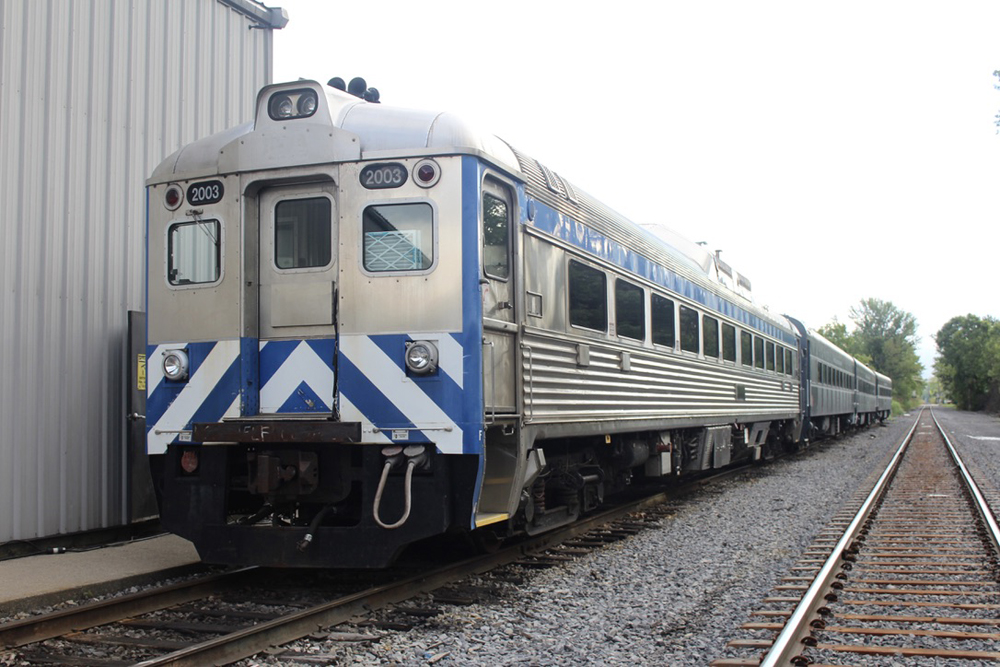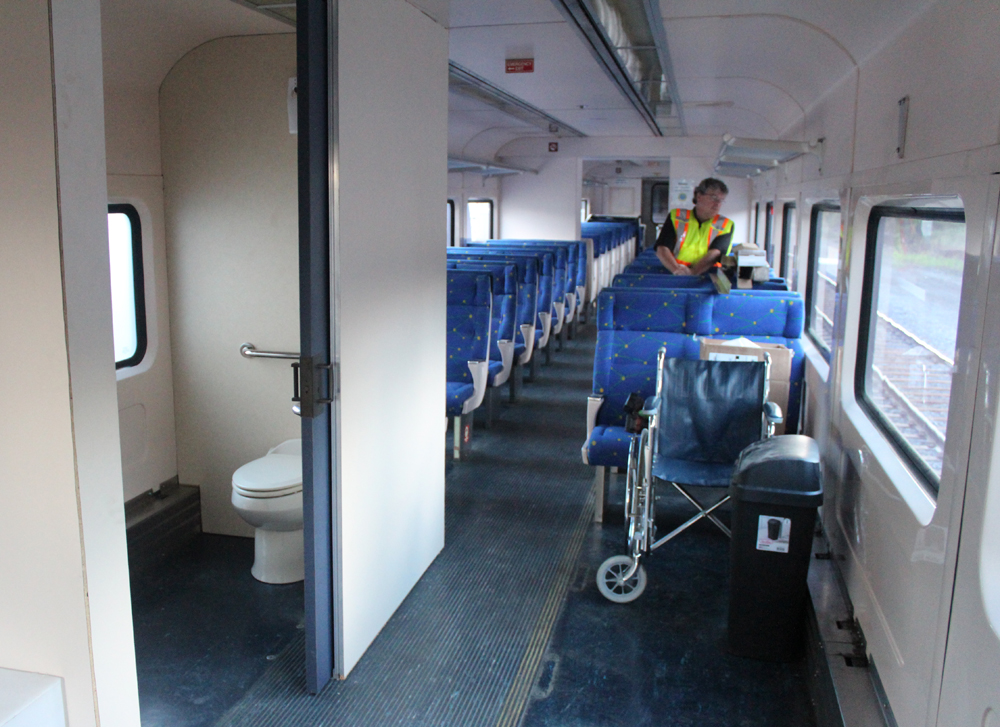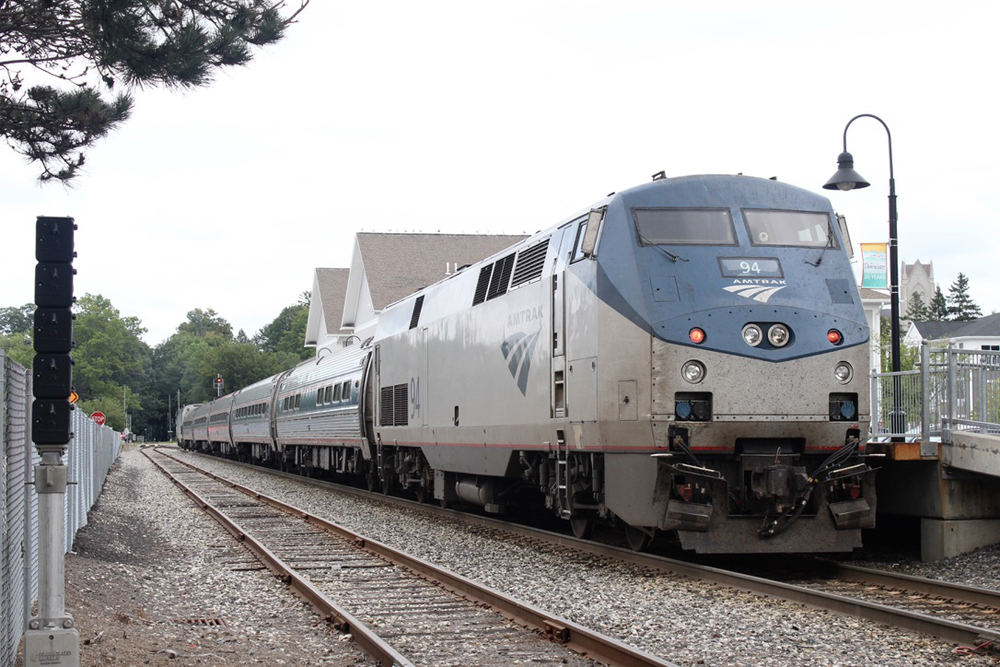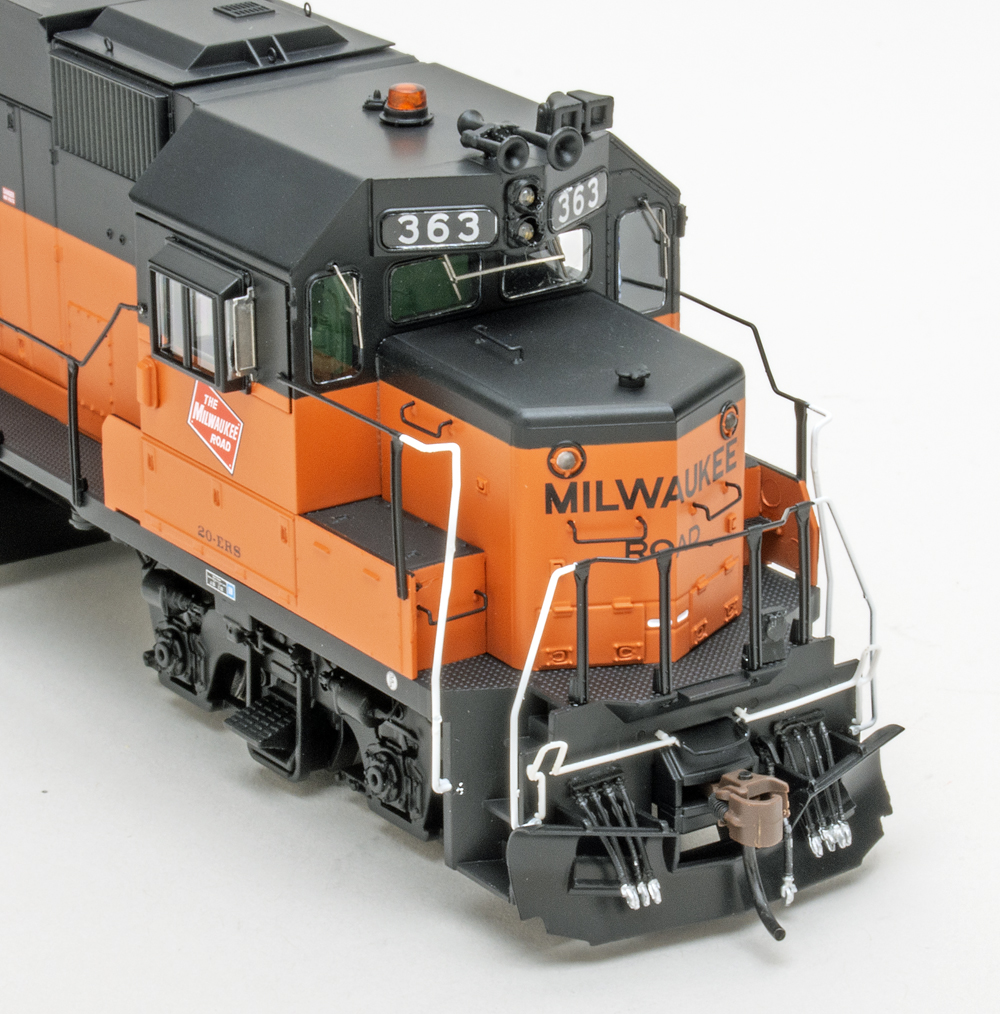
PORTLAND, Maine — The prospect of regular passenger service on a state-owned route between Brunswick and Rockland, Maine, received a big boost last week when Maine’s Department of Transportation budgeted $3 million to advance a two-year pilot project utilizing 1950s-era Budd Rail Diesel Cars.
The Camden, Maine, Courier Herald originally reported the development.
Northern New England Passenger Rail Authority Executive Director Patricia Quinn tells Trains News Wire, “The equipment and the necessary operational and safety regulatory requirements are being assessed to determine a path forward.”
Plans to extend the reach of NNEPRA’s Boston-Brunswick Downeaster an additional 56 miles to Rockland have been contemplated since seasonal excursions on the branch ended in 2015. That’s the year that the state declined to renew the operating lease of Maine Eastern, the company that had operated summer-only round trips since 2004.
Although Amtrak ran a test train over the former Maine Central branch in 2019, an intriguing proposal emerged last year when Midcoast Railservice, a subsidiary of New York’s Finger Lakes Railway, suggested using RDC equipment as part of its operating rights takeover from Canadian Pacific [see “Company offers plan for Rockland-Brunswick, Maine, passenger service,” Trains News Wire, Jan. 27, 2022].

Proactively, Finger Lakes began making modifications to one of two RDCs it has leased for tourist service from Vermont-based AllEarth Renewals, which had acquired a fleet of 14 from Dallas’ Trinity Railway Express. Rest rooms had been removed by the Texas commuter operator, so the short line’s Geneva, N.Y., shop forces installed a replacement that is compliant with Americans with Disabilities Act accessibility standards.
“We’re calling it a Coastliner,” Midcoast President Mike Smith tells News Wire, adding, “The Class 3 track between Brunswick and Rockland has been well-maintained by the state DOT; we’re planning on a running time of 1 hour, 50 minutes operating at a top speed of 55 mph.” In addition to restroom-equipped RDC No. 2003, Smith plans on making two other units available.
Logistics still must be hammered out between Midcoast, NNEPRA, the Federal Railroad Administration, and Amtrak; a launch by the summer 2023 is being targeted.
In a News Wire interview last August, Quinn said, “Everybody is onboard; we just have to figure out what the formula is. There’s a mobility opportunity to provide a year-round alternative to the automobile, that’s why we would like to see three round trips a day, seven days per week.” She points to the only alternative, two-lane U.S. Route 1, as congested in the summer tourist season and a challenge in winter.
Most passenger rail startups consume cash by beginning with a ridership study, but that isn’t happening here. As Midcoast’s Smith puts it, “We can just run the damn service and see if it works!”















Cool and intelligent!
The use of refurbished RDC’s on regional/State rail is brilliant and the Brunswick-Rockland, ME proposal is the perfect example. These trains were a mainstay back in the 50s -70s for many railroads prior to mergers and State acquisitions (think-B&M, B&O, Santa Fe.) The RDCs require no “turn-around”, can be run with only one car in more remote areas, and linked-up to multiple lines into longer trains off branches. Their “Sherman Tank” engines run on diesel fuel, the Buddliners were built solid, by a dedicated and knowledgeable railcar manufacturer who were primarily responsible for “lightweight” railcars. New replacement parts can be fabricated from old parts where needed. The versatility of these beauties are still present on Reading Northern, and a few other “local” railways, and were/are strongly represented on VIA rail in Canada. These trains can enhance many State run authorities around the country efficiently, and cheaply. Yes, I’m a railfan of RDCs, but that doesn’t diminish the added value that RDC’s can provide.
RDCs – Take a lickin’ and keep on tickin’!
Here is an incredibly positive development from Maine–which also in a very real degree vindicates Vermont entrepreneur Dave Blittersdorf’s decision to purchase a fleet of RDCs for his AllEarth Rail plan, that he hoped would be used in regional service in Vermont. That so far has not come to pass–due to lack of support from the state and carriers here–but Maine is now on-board.
So congratulations to the Northern New England Passenger Rail Authority, to Finger Lakes Lakes Rail subsidiary Midcoast Rail and to their visionary leadership–Patricia Quinn at the NNPRA, Mile Smith President of Finger Lakes Rail and his passenger wiz my friend Deb Fox on a genuine triumph!
In so many ways this is a model not only as a project, but also as a way to do something without years of multi-million dollar “studies and plans”. We all know this line supported a tourist service for many years under its previous contractor the Morristown & Erie’s Maine Eastern RR, even most of the time without proper connections to the DOWNEASTER. There were cost issues with the loco-hauled train-sets used then. This should work even better with RDCs and I think will probably have year-round applicability. Indeed my sole concern with this plan is the intent to run only a Friday to Sunday service. I genuinely feel at least one run will be needed daily.
There will be two valuable markets along the coast–Amtrak connecting riders on the DOWNEASTER from Boston/Portland and (with somewhat different schedule needs) tourists looking for day trips to Bath, Wiscasset and particularly Rockland. These riders may not want to wait for the first Amtrak arrival from Boston at Brunswick. I suspect there will be a use for a minimum of two daily round-trips between Brunswick and Rockland–one from/to Amtrak and one for local tourist riders. The Amtrak trip should ultimately be supportable year-round. The tourist trip only in season.
I recall that Maine first invested in the Class Three Track upgrades on the line with an eye towards serving workers at the Bath Iron Works. There still could be a use for a very local Portland-Bath service timed to shifts at the shipyard there. And a further Bath Iron Works train would be another matter–obviously needing more cars.
When the RDCs were in service on the DART commuter service between Fort Worth and Dallas the on-board toilets were foolishly (cruelly?) removed, a mistake shown being corrected right now at the Finger Lakes Rail shop. Connections with Amtrak must be coordinated. Ideally a joint ticketing arrangement needs to be in place for thru riders connecting from Amtrak to Midcoast “Coastliner” RDC service. It would help if circulator buses were provided at least in Bath and Rockland–where the local attractions are not adjacent to the stations, as the waterfront area is in Wiscasset.
But this is an exciting, creative and so very sensible use of what would otherwise be a purely tourist train ride as a properly integrated part of the rail network. I can hardly wait for whatever date next summer (hopefully) that this service begins.
AllEarth Rail has more serviceable RDCs at it’s Barre, VT yards/shops and a massive supply of parts acquired when the cars were purchased from DART. Mr. Blittersdorf’s original dream of regional services remains viable and enticing. These cars could be operated by NECR/VRS crews to keep costs reasonable.
Here’s one example service. What about a day-trip oriented morning trip from Rutland and Middlebury into Burlington–with an afternoon/evening return? If the under 8 mile Burlington–Essex Jct branch was put into passenger condition (which is a long-term Vermont State Rail Plan priority) this train could continue to Montpelier (and Barre) and allow day-trips in state to Middlebury, Burlington and the state capitol region.
Long-term the RDCs can be upgraded by new DMUs (Diesel Multiple Units), but RDCs are running on contemporary regional Reading Northern lines in Pennsylvania’s Pocono Mountains today. They will bridge the gap and their much lower operating costs (compared to loco-hauled services) make such new runs feasible.
All Aboard in Maine!
In the mea culpa department there are a bunch of passenger rail services in the Dallas/Fort Worth area (Tex Rail, DART, Amtrak, “A” Train and Trinity Rail Express) and I misnamed the RDC operator above. DART runs the vast Dallas Light Rail network. The RDCs ran on the Trinity Rail Express line and later briefly on the “A” Train line before it got a fleet of new DMUs. The RDC cars were sold to AllEarth Rail by Trinity Rail when it took deliver of its loco-hauled new Bombardier train-sets. I get crow for dinner!
I LOVE THE IDEA. Runit and see if they actually COME and if they don’t STOP. Seems simple enough.
I always thought a pair of RDC’s running between Kalamazoo and Grand Rapids, connecting with the higher speed Amtraks in Kalamazoo AND stopping at the decent sized casino in Bradly would be a great place to try the concept out. 40 mile run on Grand Elk. They run one freight each way a day, line is in decent shape too. DO IT.
The concept of an experimental service is something that could be applied in lots of places nationwide. Maybe you can’t run numerous round-trips a day at 79 MPH right away, but you can get an idea of the public’s acceptance of the service without risking large amounts of stranded capital.
Services can usually be started for a fraction of the full build-out cost. If initial ridership looks promising, start the next phase of improvements and maybe add another round-trip. Proceed from this point on in phases as circumstances justify it.
You don’t need to do 20 years of studies for millions of dollars, so the consultants will tell you this idea won’t work. Not true. Find some good, solid people with good rail passenger knowledge (sometimes known as “rails” by railroad people) who can talk and work well with any reluctant freight railroad.
Strongly consider qualified operators (i.e. Herzog) as alternatives to direct Amtrak operation. Amtrak can be a background partner for connections, reservations, and perhaps some equipment.
Amtrak would require millions to run this. My understanding is it is the freight operator stepping up to run freight service. And the line had regular summer service until 2015.
I love the run the damn thing and find out attitude. Ohio has spent millions upon millions to study the 3C Corridor. Enough that one could have ran trains and found out who actually will ride.
Reading Company ran its entire passenger service beyond the electrification with 16 RDC’s and, one trip a day for the Push-Pull train with a pool of 3 FP7″s and 6 modernised coaches.
With 16 RDC’s they needed 13 to make the street weekday mornings.
Keep AmtraK OUT and will probably be a success.
Since these RDCs were run fairly recently in Texas, I’d be curious to know what improvements/modifications or modernizations were carried out. Anyone familiar?
Maybe do some additional winter / colder temps modifications ?
The TRE Budds were built for CP and Canadian National, so they’re probably already ready for cold weather operation.
As Midcoast’s Smith puts it, “We can just run the damn service and see if it works!”
I’m not familiar with Mike Smith’s background, but that sounds like a real railroad manager talking.
DAN – That part I agree with and like you I find it refreshing. Why pay a consultant $5 Million to tell you what you could figure out on the back of an envelope.
So I’m with on that. Aside from that I’m skeptical. It doesn’t make any sense to plan a passenger service on the basis that someone found some surplus RDC’s manufactured a billion years ago to the standards of that day.
Mike Smith was one of the New York Central’s Al Perlman’s whiz kids , the guys who loved trains. He has done a fantastic job on restoring and maintaining traffic on the old Auburn Road’s Finger Lakes Railroad.
Time was, I loved RDC’s. That time was, like 1958 on New Haven’s Providence Local. If FRA approves these I’d be quite surprised.
Why change at Brunswick? Why not extend the existing Amtrak trainsets to Rockland? If backup is required, the trains are so equipped as far as I know with a loco on each end.
Oh, and no one reading these pages would be interested in my rap on the major cities across America with token or zero rail passenger service. There’s always Rockland, Maine.
Amtrak would not “run the damn service and see if it works.” Would take them years. Still no reinstatement of the Adirondack. Reading & Northern seems to be fine running their RDC’s. Of course, you probably can’t plug in your phone and stare at a tiny screen instead of looking out the window.